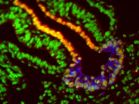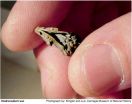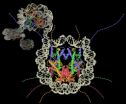FIGO's new classification of causes of abnormal uterine benefits patients
Published in the International Journal of Gynecology & Obstetrics
2011-05-20
(Press-News.org) Philadelphia, PA, May 18, 2011 – Abnormal uterine bleeding (AUB) in women of reproductive age may be due to a wide range of disorders or pathologies. Until now, there has been no universally accepted method for classifying such patients, which has impeded basic science and clinical investigation, as well as the practical, rational, and consistent application of medical and surgical therapy. As the result of a stringent 5-year review process, a multinational group of clinician–investigators with broad experience in the investigation of AUB has now agreed on a classification system to facilitate multi-institutional investigation into the epidemiology, etiology, and treatment of women with acute and chronic AUB. This classification has been approved by the International Federation of Gynecology and Obstetrics (FIGO) Executive Board as a FIGO classification system and has been published in the International Journal of Gynecology & Obstetrics.
"There has been general inconsistency in the nomenclature used to describe abnormal uterine bleeding in reproductive aged women, and there is a plethora of potential causes—several of which may coexist in a given individual," commented Malcolm G. Munro, MD, FRCS(c), FACOG, Professor of Obstetrics and Gynecology at the David Geffen School of Medicine, UCLA and Director of Gynecologic Services, Kaiser Permanente, Los Angeles Medical Center, Los Angeles, California. "It seems clear that the development of consistent and universally accepted nomenclature is a step toward rectifying this unsatisfactory circumstance. Another requirement is the development of a classification system for the causes of AUB, which can be used by clinicians, investigators, and even patients themselves to facilitate communication, clinical care, and research."
Beginning with workshops in 2005, contributors from more than 17 countries on 6 continents developed the PALM-COEIN (pronounced "pahm-koin") classification system for causes of AUB in the reproductive years. The basic system comprises 9 categories: The first 4 are defined by visually objective structural criteria (PALM: polyp; adenomyosis; leiomyoma; and malignancy and hyperplasia); a second 4 that are unrelated to structural anomalies (COEI: coagulopathy; ovulatory dysfunction; endometrial; and iatrogenic), and a final category reserved for entities that are not yet classified (N). A draft system was developed and revised, distributed for comments, and then discussed at a face-to-face meeting held in association with the 2009 FIGO World Congress in Cape Town, South Africa.
The process was systematically designed to create a practical system that could be used by clinicians in most countries worldwide to classify patients with AUB readily and consistently. Drs. Munro, Critchley and Fraser note that it is "recognized that the system will require periodic modification and occasional substantial revision depending on advances in knowledge and technology, and increasing availability of investigative options across geographic regions. Consequently, we recommend a scheduled systematic review of the system on a regular basis by a permanent committee of an international organization such as FIGO, which has already endorsed the establishment of a suitable ongoing Working Group on Menstrual Disorders."
FIGO Chief Executive Hamid Rushwan said: "There is no existing classification of the causes of these common gynecologic symptoms that allows good communication between practicing clinicians and researchers, and which encourages focus on the optimal approaches to modern management. Therefore, FIGO is pleased to have a role in facilitating the use of this ground-breaking new classification worldwide."
INFORMATION:
An accompanying special editorial provides additional insights about the classification system. Both the classification and editorial are available to download free of charge from www.figo.org (Publications section).
The article is "FIGO classification system (PALM-COEIN) for causes of abnormal uterine bleeding in nongravid women of reproductive age" by Malcolm G. Munro, Hilary O.D. Critchley, Michael S. Broder, and Ian S. Fraser; for the FIGO Working Group on Menstrual Disorders (doi: 10.1016/j.ijgo.2010.11.011). The editorial is "The FIGO classification of causes of abnormal uterine bleeding" by Malcolm G. Munro, Hilary O.D. Critchley, and Ian S. Fraser (doi: 10.1016/j.ijgo.2011.01.001). Both appear in the International Journal of Gynecology & Obstetrics, Volume 113, Issue 1, April 2011, published by Elsevier.
END
ELSE PRESS RELEASES FROM THIS DATE:
2011-05-20
A human genetic variant associated with an almost 30 percent reduced risk of developing severe malaria has been identified. Scientists from the Bernhard Nocht Institute for Tropical Medicine (BNITM), Hamburg, and Kumasi University, Ghana, reveal that a variant at the FAS locus can prevent an excessive and potentially hazardous immune response in infected children. The study appears in the open-access journal PLoS Genetics on May 19.
Severe malaria is a major public health burden in Sub-Saharan Africa, where approximately one million individuals die each year as a result ...
2011-05-20
A rose by any other name would smell as sweet; the saying is perhaps a testament to the acute sense of smell that is unique to mammals. Paleontologists have now discovered that an improved sense of smell jumpstarted brain evolution in the ancestral cousins of present-day mammals. The research will appear in the 20 May 2011 issue of the journal Science, which is published by AAAS, the international, nonprofit science society.
The findings may help explain why mammals evolved such large and complex brains, which in some cases ballooned 10 times larger than relative body ...
2011-05-20
Mammals first evolved their characteristic large brains to enable a stronger sense of smell, according to a new study published this week in the journal Science by paleontologists from The University of Texas at Austin, Carnegie Museum of Natural History and St. Mary's University in San Antonio.
This latest study is the first to use CT technology, similar to medical scanners, to reconstruct the brains of two of the earliest known mammal species, both from the Jurassic fossil beds of China. The 3D scans revealed that even these tiny, 190-million-year-old animals had developed ...
2011-05-20
PHILADELPHIA – Discovering the step-by-step details of the path embryonic cells take to develop into their final tissue type is the clinical goal of many stem cell biologists.
To that end, Kenneth S. Zaret, PhD, professor of Cell and Developmental Biology at the Perelman School of Medicine at the University of Pennsylvania, and associate director of the Penn Institute for Regenerative Medicine, and Cheng-Ran Xu, PhD, a postdoctoral researcher in the Zaret laboratory, looked at immature cells called progenitors and found a way to potentially predict their fate. They base ...
2011-05-20
Pittsburgh, Pennsylvania… Paleontologists have often wondered why mammals—including humans—evolved to have larger brains than other animals. A team of paleontologists now believe that large brains may have developed in mammals to facilitate an acute sense of smell, according to a new paper published today in the prestigious journal Science. The team also noticed enlargement in the areas of the brain that correspond to the ability to sense touch through fur; this sense is acutely developed in mammals.
Scientists used high-resolution CT scans to study rare 190-million-year-old ...
2011-05-20
After the death of Osama bin Laden, New York personal injury lawyer David Perecman reaffirmed his commitment to help the heroes who are still battling illnesses connected to 9/11.
For many individuals, the death of bin Laden brought closure. The death also served to rekindle memories of those who volunteered to assist at the World Trade Center site after the 9/11 attacks.
The lives of many Ground Zero volunteers were changed in challenging ways. Rescue and recovery workers and others are still suffering from health consequences related to the World Trade Center disaster.
"People ...
2011-05-20
SEATTLE – Researchers at Fred Hutchinson Cancer Research Center have discovered a new drug target for squamous cell carcinoma – the second most common form of skin cancer. Scientists in the laboratory of Valeri Vasioukhin, Ph.D., have found that a protein called alpha-catenin acts as a tumor suppressor and they also have unlocked the mechanism by which this protein controls cell proliferation.
The findings by Vasioukhin and colleagues will be published May 24 in Science Signaling.
For the study, the researchers studied mice that were bred to lack a copy of the gene that ...
2011-05-20
Scientists at Penn State University have achieved a major milestone in the attempt to assemble, in a test tube, entire chromosomes from their component parts. The achievement reveals the process a cell uses to package the basic building blocks of an organism's entire genetic code -- its genome. The evidence provided by early research with the new procedure overturns three previous theories of the genome-packaging process and opens the door to a new era of genome-wide biochemistry research. A paper describing the team's achievement will be published in the journal Science ...
2011-05-20
In March, four Democratic U.S. Senators, Harry Reid, D-Utah, Chuck Schumer, D-N.Y., Frank Lautenberg, D-N.J., and Tom Udall, D-N.M., drafted a letter requesting that Apple, Google and Research in Motion (or RIM) eliminate the applications (user-friendly computer programs for specific tasks) on mobile communication devices that warn drivers of the locations of drunk-driving checkpoints.
The next day, RIM, the manufacturer of the BlackBerry agreed to the removal of driving-under-the-influence (DUI/DWI) checkpoint functionality on its BlackBerry devices.
Google later ...
2011-05-20
On Friday, April 1, 2011, a Southwest Airlines Boeing 737-300 experienced a rapid decompression when the metal fuselage skin tore apart, leaving a 5X1 foot hole. This kind of event is rare, but can, and has been, catastrophic when it does occur.
In 1988, another Boeing 737, a 200 model, experienced a similar, but much worse, event over Hawaii. In that case, the skin on the entire front section of the aircraft cabin was denuded, leaving the passengers sitting in the first several rows completely exposed, with the aircraft being held together by two metal spars running ...
LAST 30 PRESS RELEASES:
[Press-News.org] FIGO's new classification of causes of abnormal uterine benefits patients
Published in the International Journal of Gynecology & Obstetrics


